Category: Uncategorized
Onomastics / names and naming : the Tektonomastics Project
I recently learned of a field of study called onomastics, the study of names (how perfect) there are also has sub-disciplines: geonomastics or toponomastics (the naming of places) and anthroponomastics (the study of personal names). I wondered if there was a field of research that investigated the more specific naming of houses. While waiting on a couple of onomastics books to arrive at the library, I came across the Tektonomastics project.
“Tektonomastics” is a made-up word, combining “tekto-” — Greek for “building” — with “onomastics” — the study of the history and origin of proper names. [1]
For this project Haruka Horiuchi and Frank Hebbert created a new word, Tektonomastics, to describe their field of inquiry – the origin of building names. Their project entails the mapping of named residential buildings in New York both through their own efforts and through crowdsourcing.
This article from Daily Design Idea details their criteria for inclusion and the process they have developed. I really like how they have presented their data both in the map and inventory, and the visualisation of their taxonomy of building names is inspired. Its provided me with a great deal of inspiration for the Online Casino Real Money NZ.

Taxonomy of residential buildings in New York
It is not surprising, but by looking at this visual representation of their taxonomy I can immediately see the student flats of Dunedin have quite a different taxonomy – what is evident is that naming a building provides a sense of identity and belonging.
References
[1] Tektonomastics: the building names project
http://urbanomnibus.net/2010/10/tektonomastics
The making of signs
Generally students make their own signs for their flats, and usually they are made from whatever is readily and cheaply available. Signs vary enormously in their design and the materials used to construct them. Lack of availability of tools and cash for raw materials mean signs are often fairly basic in their design and limited in their execution.
However, there have been inventive materials used over the years, including headboards, cupboard doors, villa doors, white boards, skateboards and planks from beer crates. Sometimes the name is spray painted on a vinyl couch, or written in liquid chalk or vivid (permanent marker) on a window. More recently materials like vinyl type and 3D letters have become more affordable and can be seen in some signs. The creativity students display in the creation of signs is one of the aspects I really enjoy about this project.
Moe’s is a good example of a named flat, while it is currently without a sign, that has had a variety of signs in it’s 19 year history. The sign below was made using a cupboard door, this sign replaced a yellow skateboard (surely a reference to Bart’s skateboard on The Simpson’s?!) with “Moe’s” spray painted on it in black.
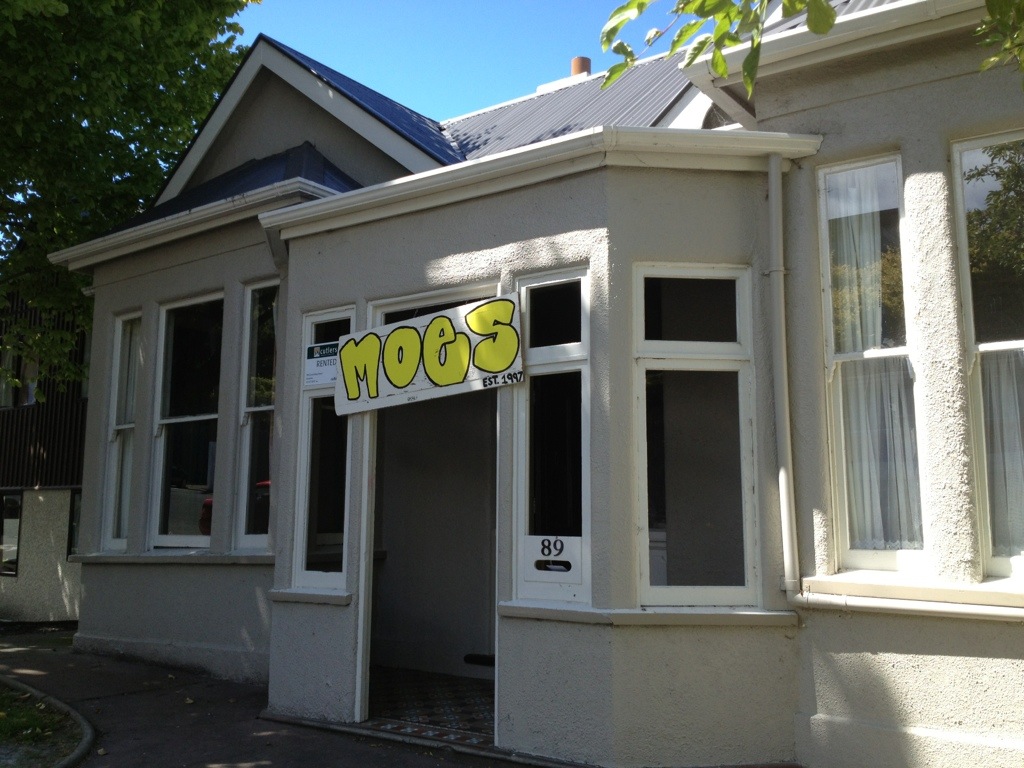
Moes, 89 Clyde Street (2013).
Some students and landlords commission the construction of signs, usually from a commercial outfit, but a new (to me at least) market has emerged. Recently I met Jasper, a 4th year student, who for the last three years has been making flat signs on commission. Jasper constructs the signs at home in the family garage where he has access to tools and materials over the summer break, fitting this in while also working full-time.
He has a couple of years of flatting experience behind him, but his most memorable flat is his first which was named. We all know it – Pics’s Flat. Inspired by The V Flat across the road on Dundas Street, the flatmates approached Pics Peanut Butter for sponsorship. After consulting with their landlord Jasper created the sign which was screwed into the lintel over the door. This was the first sign he made; it has since been stolen.
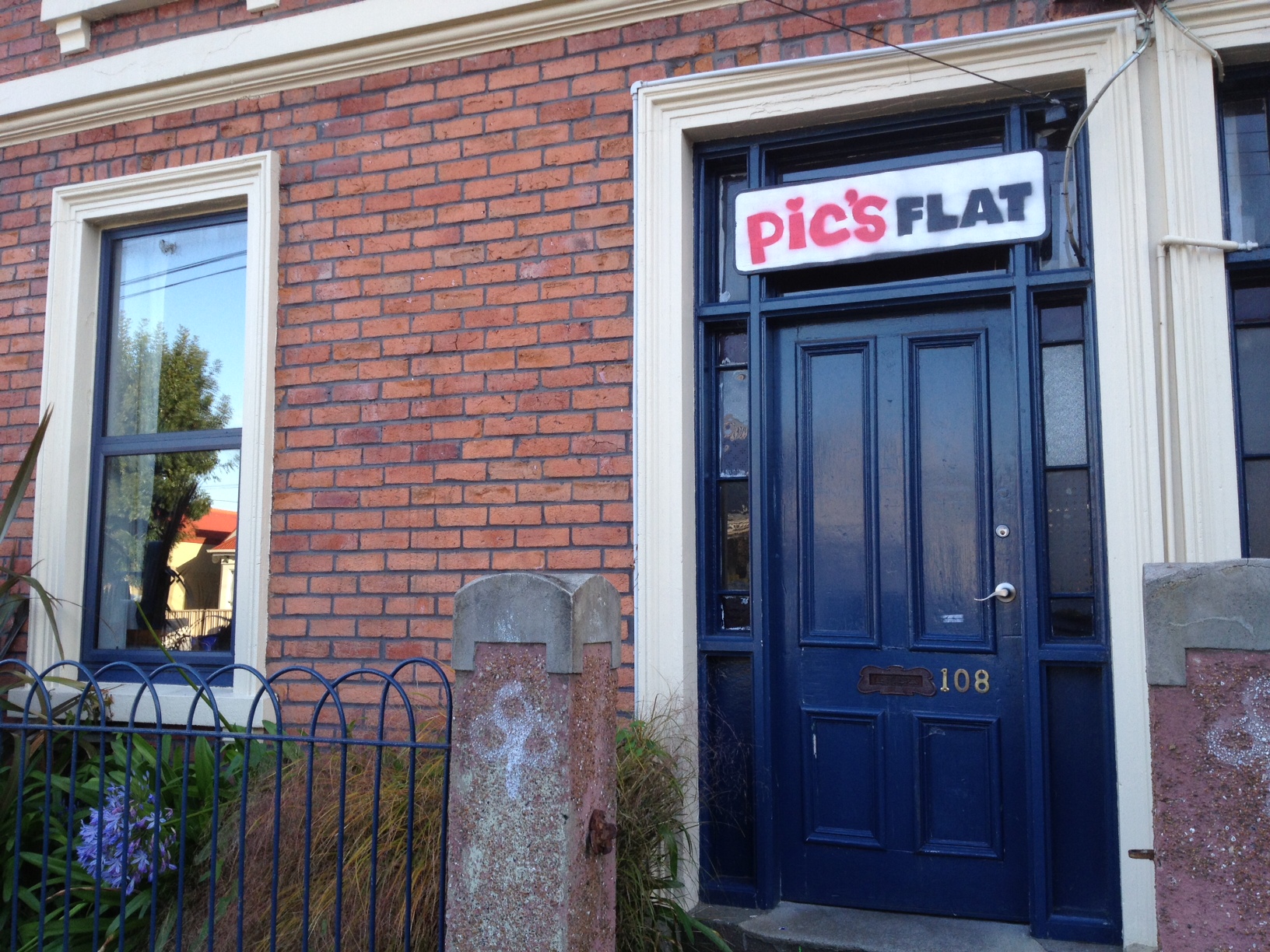
Pic’s Flat, 108 Dundas Street (2014)
To date Jasper has made about 12 signs and has designed several more. He advertises at the end of the year on Otago Flatting Goods Facebook page and students usually approach him with a name in mind – he said the majority are interesting, unique names. Jasper consults with the residents, mocks up the design in Photoshop offering a couple of alternative designs and once it’s signed off, he builds the sign. Some of the designs can be fairly complex, like the Shrieking Shack (stolen last year) which involved using a jig-saw to cut out each letter. The Hoe-tel, another of Jaspers creations on Castle Street, was stolen and he remade the sign for the residents based on a photo they sent him.
Occasionally a landlord is also involved in the design process. Recently a pair of flats on Leith Street commissioned a flat sign (apparently the landlord’s idea); the sign-off on the name and design required the agreement of the 12 female residents (split across two flats) and the landlord. That flat is The Dolls House on Leith Street.
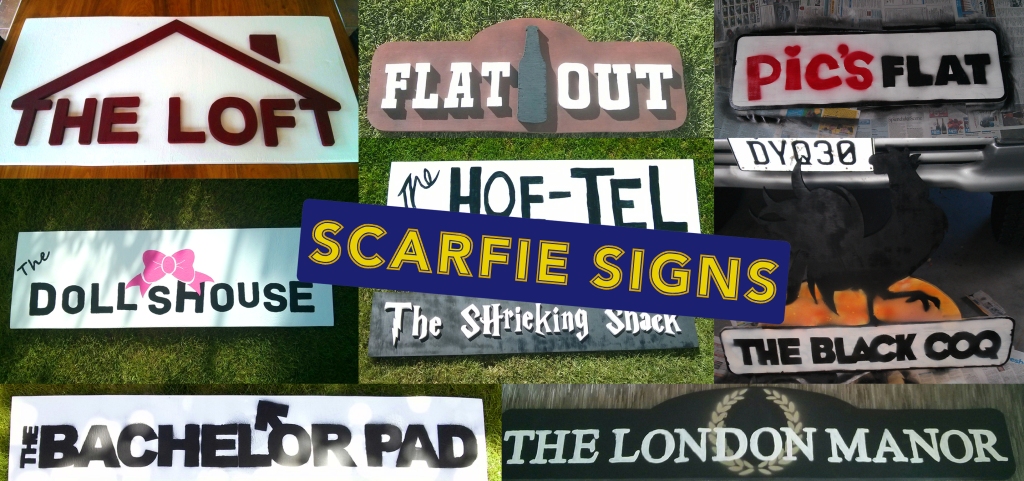
Collage of signs. Source Jasper Fawcett. Used with permission
Given that several of the signs Jasper has made have been stolen I wasn’t surprised to hear that he thinks the signs should stay with the flats. Often signs stay in-situ, sometimes students take them to their next flat where they may or may not be displayed. It raises the question why someone would steal student flat signs when they are so easily identifiable … is there a collector out there?
I was interested in Jasper’s opinion on why students name their flats. He said that in his experience, students leaving halls often first look for flats with names to rent because it’s cool to live somewhere with a name and it’s easier (and more fun) to refer to your flat by name than by street number. He believes most landlords are ok with the practice because it attracts students to the property. He feels that flat signs are part of the student culture here in Dunedin.
Students certainly do refer to flats by name and use them as a mechanism of way-finding. On my way in to campus to meet Jasper, I overheard a conversation between two students on Howe Street.
Student 1: “Are you doing anything tonight?
Student 2: “Yeah, I’m going to that party on Leith Street.”
Student 1: “At The Nunnery?”
Student 2: “Yeah.”
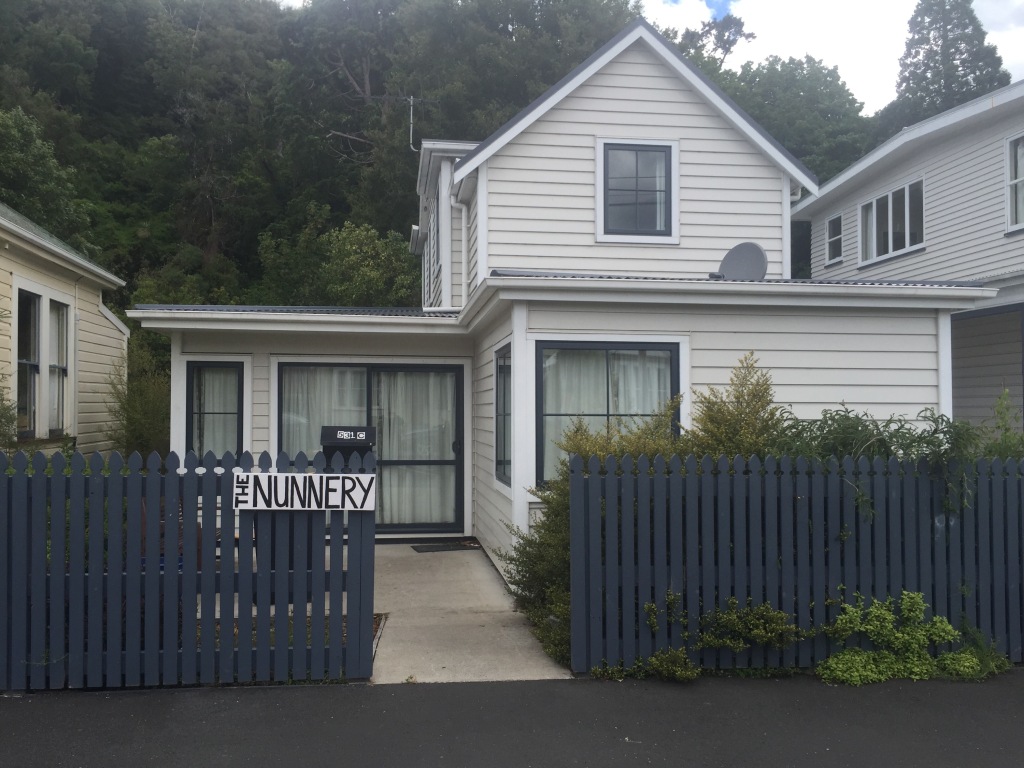
The Nunnery, Leith Street (2015)
Balcony collapse on Castle Street at Six60 gig
It’s the worst. It’s not something you ever want to experience or have anyone else experience, but it has happened. We often see students hanging out on roofs and balconies during parties, but this evening, during a Six60 gig on Castle Street, a balcony collapsed. Many people were hurt and nine seriously enough to be taken to hospital.
There’s been plenty of news and social media posting about the accident which I’ve collected here in this Storify.
I sincerely hope that everyone who has been injured will recover quickly and that they receive the support they need. Please get in touch with OUSA and Student Health Services if you need to, and do check in with your families.
Keeping in touch with home
A couple of years ago I wrote a post about correspondence and how mechanisms of communicating have changed over the last couple of decades. Since student flats have been named, students have communicated their contact details in a number of ways. In my first year in 1991 I went through a $5 packet of stamps a week and included my flat name as part of my return address, and I would received mail with my flat name on it too.
Between the 1930s and the 1970s some named flats (Ches Choux and The Spanish Slum) commissioned printers to create letterhead that stated their flat name and address. Occasionally like in the case of The Bach (1930s), the letterhead also included a crest and motto!
Telephone
Another aspect of communication has changed, the telephone. In the 1960s and 1970s it wasn’t possible to list a name in the public telephone book for free unless it was a person, anything else incurred a fee. Smerch HQ, a flat on Cumberland Street in the 1960s that was named for the Soviet spies headquarters in Ian Flemings Bond novels, managed to fudge the system by pretending their flat name was that of one Howard Quentin Smersh (that’s medical students for you!). The residents of The Lunatic Fringe around the road on Leith Street weren’t so fortunate and missed out on listing their flat in the phone book.
In the 1990s, Telecom’s name numbers became popular. Moe’s on Clyde Street took advantage of this and registered their phone number as 477 MOES – you can see it in an OUSA student telephone book that was published at the time. Of course the advent of the mobile phone has meant many flats probably no longer have a landline. More recently, residents of named flats are more likely to create a Facebook page.
Social Media
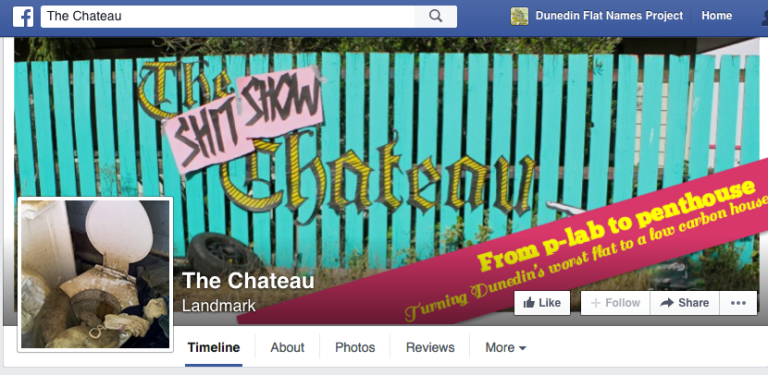
The Shit Show Chateau on London Street, voted OUSAs worst flat in 2012, created a Facebook page as a tool to communicate the progress they were making with renovating this slum property.
We have signed the official ‘Worst Flat in Dunedin’ as voted by the Mayor David Cull and former OUSA president Logan Edgar. With over 30 holes, unidentifiable stains on the walls and a damp stench it certainly lives up to the title.
Check out our journey as we turn this p-lab looking flat into a something less of a health hazard. It could even be warm, efficient and carbon friendly with the help of Generation Zero http://generationzero.org.nz/
A couple of other examples of named flats with Facebook pages have a slightly different purpose. The V Flat, Westie Pad, and Coronation Street Flats have not been named by students, but by companies (in one case, Pic’s Flat, it was the student’s idea). How students feel about living in sponsored or flats pre-named by commercial interests requires a more investigation.
As new forms of communication are developed, we begin to see their influence depicted on flat signs, and example is references to social media use. The only current example of this was the flat name, The Libra Flat, on Harbour Terrace. The sign employs a hashtag#ourpad (commonly used to create a thematic link between tweets, instagrams and Facebook posts) to mark this house as their home (our pad) as well as being a stunning pun on “feminine hygiene products”.
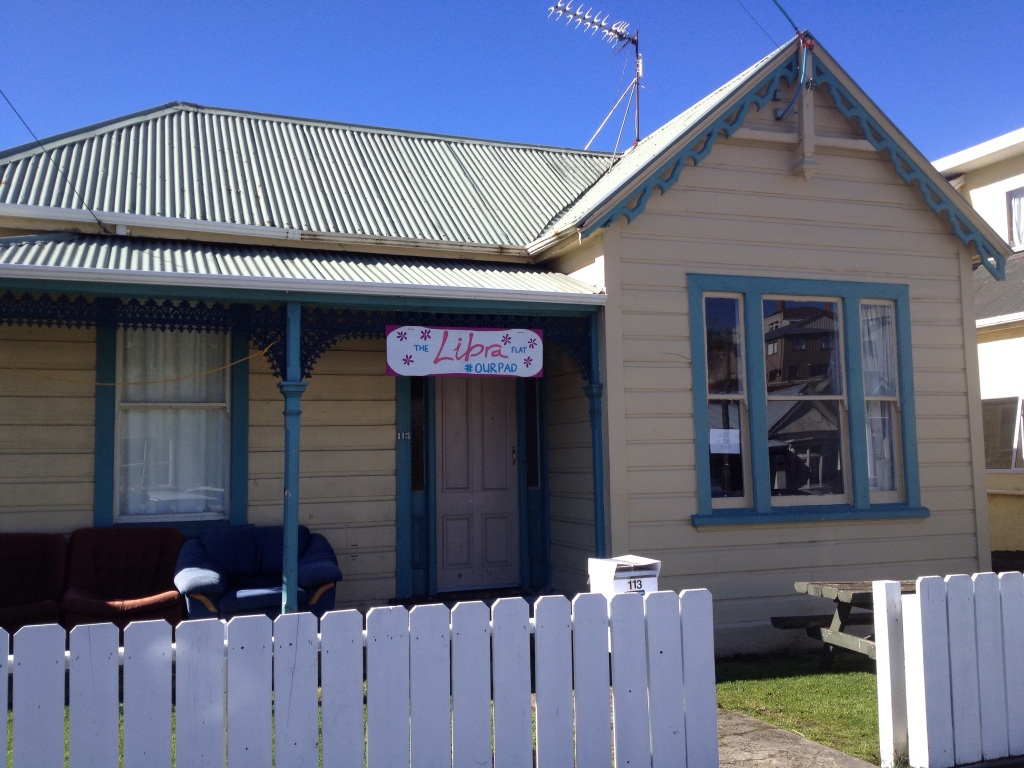
Social media has played an enormously important role in the development of this project – the extent to which will be the subject of a future blog post.
The V Flat
August and September are traditionally the months when students secure a flat for the following year, and it’s around this time, well before finals, when “flat taken” signs start appearing in windows. As university enrollments wax and wane this practice, and the number of flats available to rent, can vary.
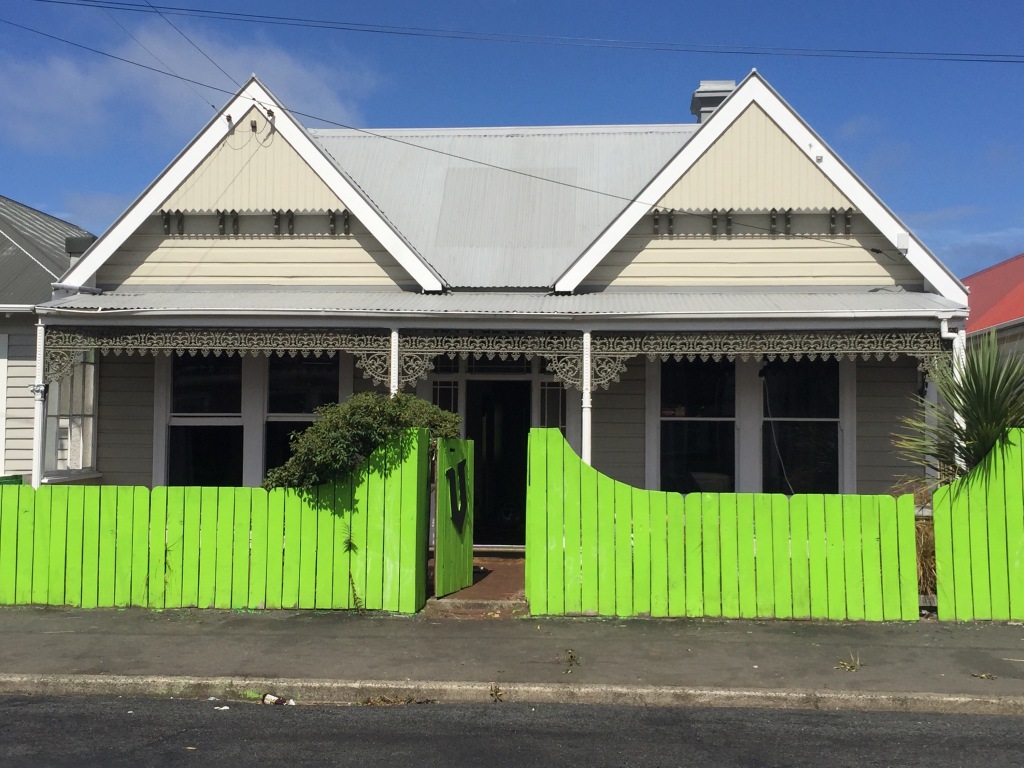
The V Flat on Dundas Street
The V Flat at 97 Dundas Street is one of the earlier sponsored flats in Dunedin and possibly the longest enduring. The V Flat appears in this August 2010 news report by Dave Goosselink for 3 News, where their annual competition is revealed – for a few minor challenges, a prize of $10,000 paid off the annual rent bill makes securing this flat an attractive prospect for students.
Their Facebook page has been active since that time and is used to share photos of the residents each year. Events are managed through their Facebook page, such as flat-warmings around Orientation Week in February, and the annual competition in August / September. Pamphlets are often found at food retailers around campus advertising their competition.
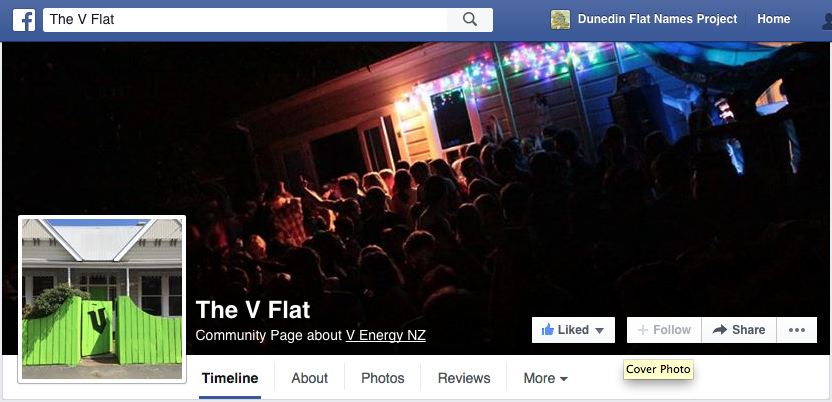
The V Flat – a sponsored flat on Dundas Street.
In February 2015, a raucous Orientation period saw The V Flat residents cancel their proposed party in O’Week because 3000 people indicated on Facebook that they would attend.
A spokesman for beverage company Frucor said the V flat party – originally scheduled for tonight – was cancelled due to “safety concerns”.
“Our number one priority is the safety of anyone attending any event associated with V,” Frucor acting marketing director Luke Rive said.
“The flatmates have been asked to cancel the party on the advice of NZ police and the university due to safety concerns, particularly in regard to flow over on to the street.”
That decision was made last week, and a Facebook page has since been taken down.
Flatmates told the Otago Daily Times they supported the decision after watching the number of people saying they would attend the event rise from a manageable several hundred people to 3000.
”It just got too big,” a flatmate said.
Did you live at the V Flat, or do you have any memories of visiting it?
Coronation Street flats / The Stafford Terraces
A landmark in North Dunedin, The Stafford Terrace at 62-86 Dundas Street, colloquially known as the Coronation Street flats, are being redeveloped. The process began in late 2015 – interiors have been stripped and the frontages cleaned up with the doors painted in bright colours. Their Facebook page tracks the renovation process of a third of the flats in the terrace.
What’s particularly interesting from my perspective is that the developer is inviting residents to name their flat and they supply a replica sign for them. The catch is it must reference a landmark from the TV programme, Coronation Street in order to “secure their place in history”.
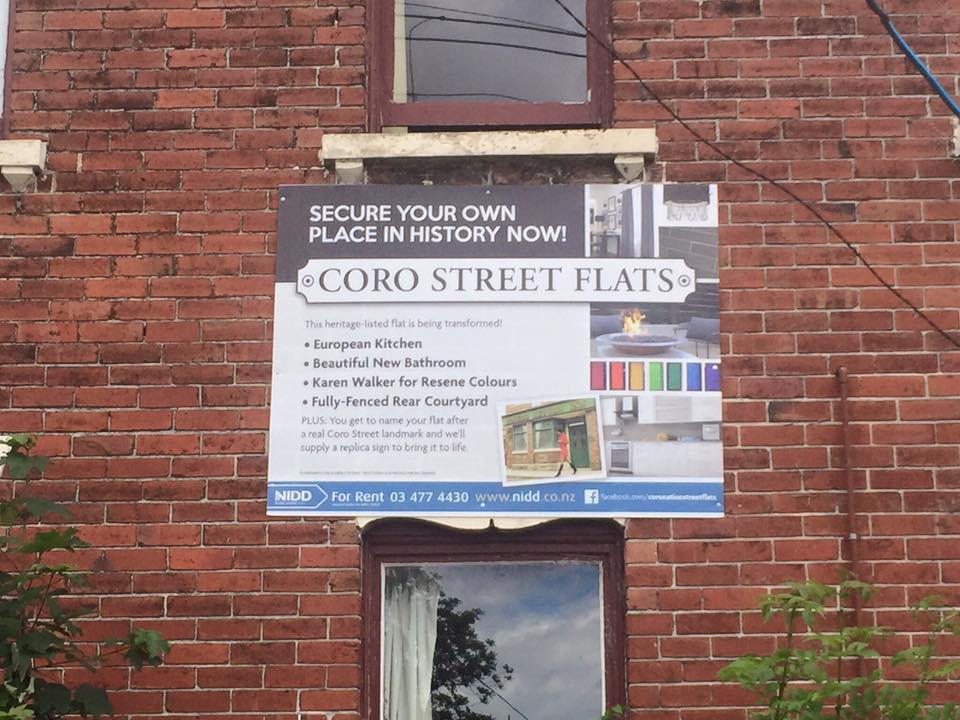
Secure your own place in history now!
The Stafford Terraces have a Category 2 listing with the New Zealand Historic Places Trust (3189). It is a significant building because it is representative of 19th century working class accommodation and investment housing. It was purpose built as a rental, and over 150 years later, it still is. The following are quotations from the NZHPT record:
“The first tenants were apparently from the lower middle class and the working class, there were painters, bootmakers, carpenters, butchers, bakers and a storeman.”
“In recent years the terraced houses have been landmark rental properties, well known to students, and an important element in the townscape of the North Dunedin student area.”
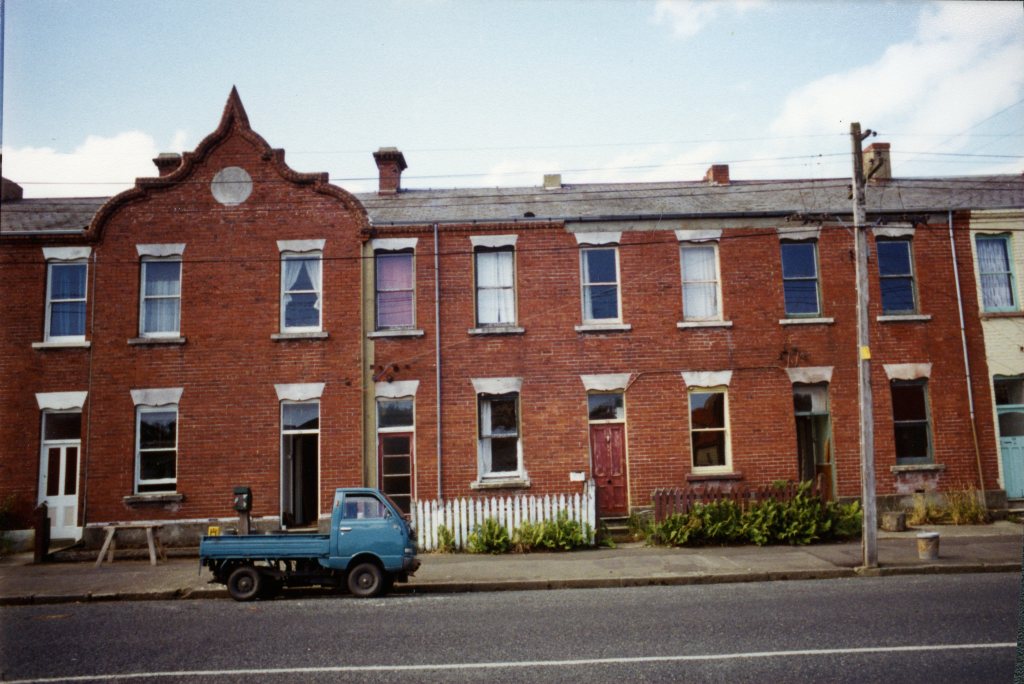
Acknowledgement: DCC Archives
The Stafford Terraces have been bestowed with a number of flat names over the years: The Shire, Chomp, The Brick Shit House, Battleship. The flat’s distinctive window frames were captured as a background image for a poster advertising the release of Husband House EP by Sneaky Feelings.
Did you or anyone you know live in these flats?